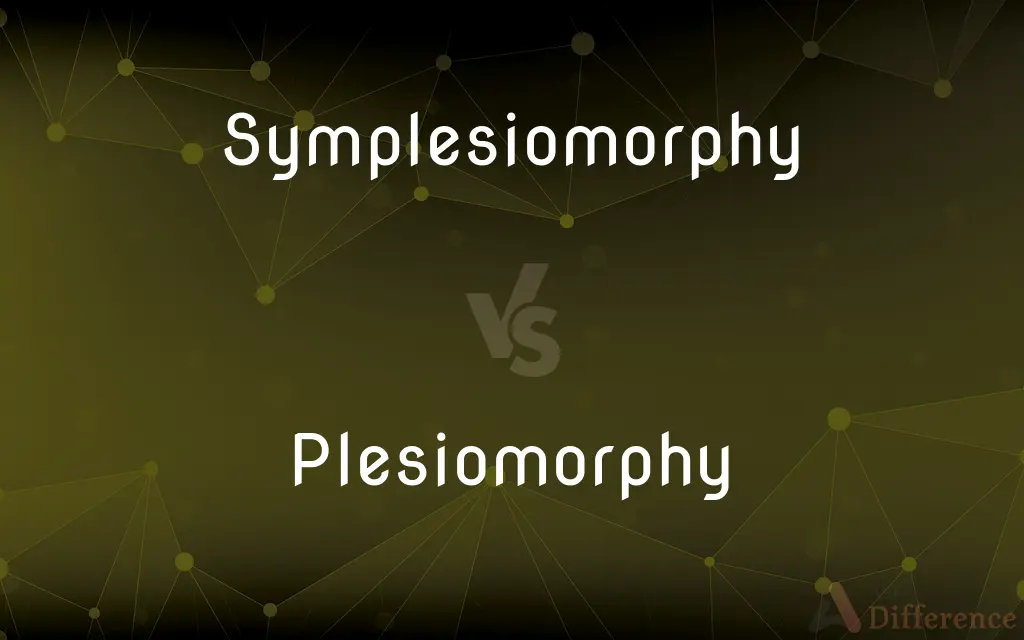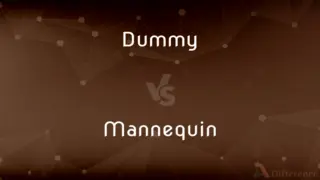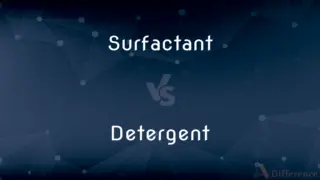Symplesiomorphy vs. Plesiomorphy — What's the Difference?
By Maham Liaqat & Urooj Arif — Updated on April 24, 2024
Symplesiomorphy refers to an ancestral trait shared by two or more taxa, whereas plesiomorphy indicates an ancient characteristic retained by a single taxon.

Difference Between Symplesiomorphy and Plesiomorphy
Table of Contents
ADVERTISEMENT
Key Differences
Symplesiomorphy involves traits inherited from a common ancestor that are shared among multiple species, highlighting evolutionary relationships. In contrast, plesiomorphy pertains to primitive traits that remain within a particular lineage without being uniquely derived or shared across different taxa.
In terms of evolutionary biology, symplesiomorphies are critical for reconstructing phylogenetic trees as they provide evidence of common ancestry. Plesiomorphies, on the other hand, are important for identifying trait conservatism in a lineage, showing how some ancient characteristics are retained over time.
Symplesiomorphies help in distinguishing between convergent evolution, where similar traits evolve independently in different lineages, and genuine phylogenetic kinship. Plesiomorphies are useful in studying the basal characteristics of a group, which might be overshadowed by more recent evolutionary developments.
The study of symplesiomorphy is often complemented by the identification of synapomorphies (shared derived traits), which are more informative for phylogenetic analysis. Meanwhile, recognizing a plesiomorphy can challenge or reaffirm the presumed evolutionary trajectory of a lineage, often requiring deeper genetic or fossil evidence to interpret.
Researchers use symplesiomorphy to explore deeper taxonomic relationships, potentially reshaping our understanding of evolutionary branches and connections. Plesiomorphy, by focusing on original traits, can lead to insights into the environmental and ecological conditions faced by ancient species.
ADVERTISEMENT
Compare with Definitions
Symplesiomorphy
A characteristic that appears primitive and is common among several taxa.
The backbone is a symplesiomorphy among all vertebrates.
Plesiomorphy
A primitive feature that persists through evolutionary time within a group.
Flowering plants still exhibiting primitive vascular tissue structures display a plesiomorphy.
Symplesiomorphy
A trait inherited from an ancestor shared among different species.
The presence of five fingers in humans and monkeys is a symplesiomorphy.
Plesiomorphy
An ancestral trait maintained in a lineage without modification.
The cloaca in reptiles and birds is a plesiomorphy.
Symplesiomorphy
An evolutionary feature indicating a shared lineage but not necessarily a recent divergence.
Gills in fish and amphibian larvae are symplesiomorphies.
Plesiomorphy
Important for understanding the foundational traits of a taxonomic group.
Feather keratin in all birds is considered a plesiomorphy.
Symplesiomorphy
A non-derived trait found in multiple descendants of a common ancestor.
The production of spores in ferns and mosses is a symplesiomorphy.
Plesiomorphy
A characteristic that predates a divergence in a lineage.
The jawless condition in lampreys and hagfish is a plesiomorphy.
Symplesiomorphy
Used in phylogenetics to support hypotheses about common ancestry.
The vertebrate skeletal structure is a symplesiomorphy useful for phylogenetic analysis.
Plesiomorphy
Reflects evolutionary conservatism, where changes are minimal over time.
The use of ammonia as an excretory product in aquatic animals is a plesiomorphy.
Symplesiomorphy
The possession by two or more organisms or taxa of a shared primitive or ancestral character not exclusive to or characteristic of them in particular; the shared character itself.
Plesiomorphy
The state of being plesiomorphic; ancestral or primitive condition as compared to a later, derived character state. Also (as a count noun): an ancestral or plesiomorphic feature or trait.
Symplesiomorphy
(cladistics) An ancestral trait shared by two or more taxa.
Plesiomorphy
An evolved character or trait that is shared by some or all members of a phylogenetic group and their common ancestor but is not unique to that group. A segmented spinal column is a plesiomorphy of mammals, being present as well in other groups such as fishes, reptiles, amphibians, and birds.
Plesiomorphy
(cladistics) A character state that is present in both outgroups and in the ancestors
Common Curiosities
What is symplesiomorphy?
It's an ancestral trait shared by two or more taxa, indicating common ancestry.
How does symplesiomorphy differ from synapomorphy?
Symplesiomorphy is a shared ancestral trait, while synapomorphy is a shared derived trait, indicating more recent common descent.
How does recognizing plesiomorphies affect our understanding of evolutionary history?
It provides insights into the evolutionary conservatism and challenges or reaffirms evolutionary trajectories.
Can symplesiomorphy be used to determine evolutionary relationships?
Yes, symplesiomorphies are used to explore taxonomic relationships and reconstruct phylogenetic trees.
Is symplesiomorphy useful in identifying convergent evolution?
Yes, it helps distinguish between traits arising from common ancestry versus those from convergent evolutionary processes.
What is the significance of studying both symplesiomorphy and plesiomorphy?
Studying both provides a more comprehensive understanding of evolutionary processes and trait development.
What is plesiomorphy?
Plesiomorphy refers to an ancestral trait that has been retained by a single taxon.
Why is plesiomorphy important in evolutionary studies?
Plesiomorphy helps in understanding the basal or original characteristics of a lineage.
What role does plesiomorphy play in the study of trait conservatism?
It shows how certain ancient characteristics are preserved within a lineage over evolutionary time.
How do researchers identify a trait as symplesiomorphic?
By comparing traits across different taxa and confirming their presence in a common ancestor.
Share Your Discovery

Previous Comparison
Dummy vs. Mannequin
Next Comparison
Surfactant vs. DetergentAuthor Spotlight
Written by
Maham LiaqatCo-written by
Urooj ArifUrooj is a skilled content writer at Ask Difference, known for her exceptional ability to simplify complex topics into engaging and informative content. With a passion for research and a flair for clear, concise writing, she consistently delivers articles that resonate with our diverse audience.













































